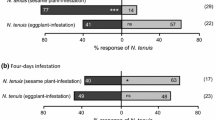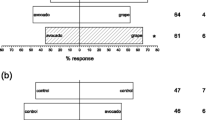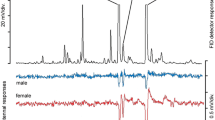Abstract
It is largely accepted that larval experience influence host-plant preference of larvae. In general, larval experience with a host plant induces both an odour and feeding preference for that plant. In a previous study, exposure of three noctuid stem borer species, i.e. Sesamia nonagrioides, Busseola fusca and B. nairobica, to a vanillin-enriched medium induced an olfactory preference for the odours of this medium in the larvae of these species. Here, we checked if the exposure to a vanillin-enriched medium also induced a feeding preference for this diet. Different life stages (i.e. neonate larvae to adults) of the three species were conditioned to an artificial diet enriched with vanillin over two generations. Thereafter, two-choice tests on third-generation larvae were done using a Y-tube olfactometer for odour preferences and diet choice experiments. Larvae of all three-species conditioned to the vanillin diet oriented significantly towards the odour of this diet, whereas the non-conditioned larvae did not. Still, apart for B. fusca, the conditioned larvae did not exhibit a feeding preference for this diet, thus odour preference did not match the feeding choice of the conditioned larvae. The implication of this result on insect’s adaptability to a new host plant in a changing environment is discussed.




Similar content being viewed by others
References
Akhtar, Y., & Isman, M. B. (2003). Larval exposure to oviposition deterrents alters subsequent oviposition behavior in generalist, Trichoplusia ni and specialist, Plutella xylostella moths. Journal of Chemical Ecology, 29(8), 1853–1870.
Anderson, P., & Anton, S. (2014). Experience-based modulation of behavioural responses to plant volatiles and other sensory cues in insect herbivores. Plant, Cell & Environment, 37, 1826–1835.
Apostolopoulou, A. A., Widmann, A., Rohwedder, A., Pfitzenmaier, J. E., & Thum, A. S. (2013). Appetitive associative olfactory learning in Drosophila larvae. Journal of Visualized Experiments, 72, e4334. https://doi.org/10.3791/4334.
Berdegué, M., Reitz, S., & Trumble, J. T. (1998). Host plant selection and development in Spodoptera exigua: do mother and offspring know best? Entomologia Experimentalis et Applicata, 89, 57–64.
Calatayud, P.-A., Ahuya, P. O., Wanjoya, A., Le Ru, B., Silvain, J.-F., & Frérot, B. (2008). Importance of plant physical cues in host acceptance for oviposition by Busseola fusca. Entomologia Experimentalis et Applicata, 126, 233–243.
Calatayud, P.-A., Ahuya, P., & Le Ru, B. (2014). Importance of the experimental setup in research on attractiveness of odours in moths: an example with Busseola fusca. Entomologia Experimentalis et Applicata, 152, 72–76.
Carlsson, M. A., Anderson, P., Hartlieb, E., & Hansson, B. S. (1999). Experience-dependent modification of orientational response to olfactory cues in larvae of Spodoptera littoralis. Journal of Chemical Ecology, 25, 2445–2454.
Carrasco, D., Larsson, M. C., & Anderson, P. (2015). Insect host plant selection in complex environments. Current Opinion in Insect Science, 8, 1–7.
Carroll, M. J., Schmelz, E. A., Meagher, R. L., & Teal, P. E. A. (2006). Attraction of Spodoptera frugiperda larvae to volatiles from herbivore-damaged maize seedlings. Journal of Chemical Ecology, 32, 1911–1924.
Chow, J. K., Akhtar, Y., & Isman, M. R. (2005). The effects of larval experience with a complex plant latex on subsequent feeding and oviposition by the cabbage looper moth: Trichoplusia ni (Lepidoptera: Noctuidae). Chemoecology, 15, 129–133.
Davis, J. M., & Stamps, J. A. (2004). The effect of natal experience on habitat preferences. Trends in Ecology and Evolution, 19, 411–416. https://doi.org/10.1016/j.tree.2004.04.006.
del Campo, M. L., & Miles, C. I. (2003). Chemosensory tuning to a host recognition cue in the facultative specialist larvae of the moth Manduca sexta. The Journal of Experimental Biology, 206, 3979–3990.
Félix, A.-E., Calatayud, P.-A., Le Ru, B., Capdevielle-Dulac, C., Ong’amo, G., Silvain, J.-F., & Frérot, B. (2013). To be or not to be a species: use of reproductive isolation experiments and genetic analysis to clarify the taxonomic status of two Busseola (Lepidoptera: Noctuidae) species in Kenya. Annales de la Société Entomologique de France, 49, 345–354.
Forbes, A. A., Devine, S. N., Hippee, A. C., Tvedte, E. S., Ward, A. K., Widmayer, H. A., & Wilson, C. J. (2017). Revisiting the particular role of host shifts in initiating insect speciation. Evolution. https://doi.org/10.1111/evo.13164.
Giurfa, M., & Sandoz, J.-C. (2012). Invertebrate learning and memory: fifty years of olfactory conditioning of the proboscis extension response in honeybees. Learning & Memory, 19, 54–66.
Glendinning, J. I., Foley, C., Loncar, I., & Rai, M. (2009). Induced preference for host plant chemicals in the tobacco hornworm: contribution of olfaction and taste. Journal of Comparative Physiology A, Neuroethology, Sensory, Neural, and Behavioral Physiology, 195, 591–601.
Hopkins, A. D. (1916). Economic investigations of the scolytid bark and timber beetles of North America. US Dep Agric Progr Work 353.
Jaenike, J. (1978). On optimal oviposition behavior in phytophagous insects. Theoretical Population Biology, 14(3), 350–356.
Janz, N. (2002). Evolutionary ecology of oviposition strategies. In M. Hilker & T. Meiners (Eds.), Chemoecology of insect eggs and egg deposition (pp. 349–376). Berlin: Blackwell.
Jörgensen, K., Stranden, M., Sandoz, J. C., Menzel, R., & Mustaparta, H. (2007). Effects of two bitter substances on olfactory conditioning in the moth Heliothis virescens. The Journal of Experimental Biology, 210, 2563–2573.
Juma, G., Chimtawi, M., Ahuya, P. O., Njagi, P. G. N., Le Ru, B., Magoma, G., Silvain, J.-F., & Calatayud, P.-A. (2008). Distribution of chemo- and mechanoreceptors on the antennae and maxillae of Busseola fusca larvae. Entomologia Experimentalis et Applicata, 128, 93–98.
Khan, Z. R., & Saxena, R. C. (1997). Use of a surrogate stem for eliciting ovipositional response of Busseola fusca (Lepidoptera: Noctuidae). Journal of Economic Entomology, 90, 1426–1429.
Knolhoff, L. M., & Heckel, D. G. (2014). Behavioral assays for studies of host plant choice and adaptation in herbivorous insects. Annual Review of Entomology, 59, 263–278.
Le Ru, B. P., Ong’amo, G. O., Moyal, P., Ngala, L., Musyoka, B., Abdullah, Z., Cugala, D., Defabachew, B., Haile, T. A., Kauma Matama, T., Lada, V. Y., Negassi, B., Pallangyo, B., Ravolonandrianina, J., Sidumo, A., Omwega, C. O., Schulthess, F., Calatayud, P.-A., & Silvain, J.-F. (2006a). Diversity of lepidopteran stem borers on monocotyledonous plants in eastern Africa and the islands of Madagascar and Zanzibar revisited. Bulletin of Entomological Research, 96, 555–563.
Le Ru, B. P., Ong’amo, G., Moyal, P., Muchugu, E., Ngala, L., Musyoka, B., Abdullah, Z., Matama-Kauma, T., Lada, V. Y., Pallangyo, B., Omwega, C. O., Schulthess, F., Calatayud, P.-A., & Silvain, J.-F. (2006b). Geographic distribution and host plant ranges of East African noctuid stem borers. Annales de la Société Entomologique de France, 42, 353–361.
Moolman, J., Van den Berg, J., Conlong, D., Cugala, D., Siebert, S., & Le Ru, B. (2014). Species diversity and distribution of lepidopteran stem borers in South Africa and Mozambique. Journal of Applied Entomology, 138, 52–66.
Mota, T., & Giurfa, M. (2010). Multiple reversal olfactory learning in honeybees. Frontiers in Behavioral Neurosciences, 4. https://doi.org/10.3389/fnbeh.2010.00048.
Ndemah, R., Schulthess, F., Le Rü, B., & Bame, I. (2007). Lepidopteran cereal stemborers and associated natural enemies on maize and wild grass hosts in Cameroon. Journal of Applied Entomology, 131, 658–668.
Ngi-Song, A. J., Overholt, W. A., Njagi, P. G. N., Dicke, M., Ayertey, J. N., & Lwande, W. (1996). Volatile infochemicals used in host an host habitat location by Cotesia flavipes Cameron and Cotesia sesamiae (Cameron) (Hymenoptera: Braconidae), larval parasitoids of stemborers on graminae. Journal of Chemical Ecology, 22, 307–323.
Noriyuki, S. (2015). Host selection in insects: reproductive interference shapes behavior of ovipositing females. Population Ecology, 57(2), 293–305.
Ong’amo, G. O. (2009). Diversity, ecology and population dynamics of lepidopteran stem borers in Kenya. Nairobi: Kenyatta University.
Ong’amo, G. O., Le Ru, B. P., Dupas, S., Moyal, P., Calatayud, P.-A., & Silvain, J.-F. (2006). Distribution, pest status and agro-climatic preferences of lepidopteran stem borers of maize in Kenya. Annales de la Société Entomologique de France, 42, 171–177.
Onyango, F. O., & Ochieng’-Odero, J. P. R. (1994). Continuous rearing of the maize stem borer Busseola fusca on an artificial diet. Entomologia Experimentalis et Applicata, 73, 139–144.
Petit, C. (2015). Induction des préférences olfactive et gustative chez les lépidoptères foreurs de graminées en Afrique de l’Est: effet des expériences pré-imaginale et imaginale. PhD (in French) of the University of Paris-Sud. 138 pp.
Petit, C., Le Ru, B., Dupas, S., Frérot, B., Ahuya, P., Kaiser-Arnauld, L., Harry, M., & Calatayud, P.-A. (2015). Influence of dietary experience on the induction of preference of adult moths and larvae for a new olfactory cue. PLoS One, 10(8), e0136169.
Petit, C., Dupas, S., Thiéry, D., Capdevielle-Dulac, C., Le Ru, B., Harry, M., & Calatayud, P.-A. (2017). Did the mechanisms modulating host preference in holometabolous phytophagous insects depend on their host plant specialization? Journal of Pest Science. https://doi.org/10.1007/s10340-017-0833-4.
R Development Core Team (2013). A language and environment for statistical computing R Foundation for Statistical Computing, Vienna, Austria. http://www.R-project.org/. Accessed 02. 02.15.
Renwick, J., & Chew, F. S. (1994). Oviposition behavior in Lepidoptera. Annual Review of Entomology, 39(1), 377–400.
Roessingh, P., Xu, S., & Menken, S. B. J. (2007). Olfactory receptors on the maxillary palps of small ermine moth larvae: evolutionary history of benzaldehyde sensitivity. Journal of Comparative Physiology A, 193, 635–647.
Salloum, A., Colson, V., & Marion-Poll, F. (2011). Appetitive and aversive learning in Spodoptera littoralis larvae. Chemical Senses, 36, 725–731.
Saxena, K. N., & Schoonhoven, L. M. (1982). Induction of orientational and feeding preferences in Manduca sexta larvae for different food sources. Entomologia Experimentalis et Applicata, 32, 173–180.
Scheirs, J., Zoebisch, T. G., & De Bruyn, L. (2004). Optimal foraging shapes host preference of a plyphagous leafminer. Ecological Entomology, 29, 375–379.
Silva, B., Molina-Fernandez, C., Ugalde, M. B., Tognarelli, E. I., Angel, C., & Campusano, J. M. (2015). Muscarinic ACh receptors contribute to aversive olfactory learning in Drosophila. Neural Plasticity. https://doi.org/10.1155/2015/658918.
Stewart, S., Koh, T.-W., Ghosh, A. C., & Carlson, J. R. (2015). Candidate ionotropic taste receptors in the Drosophila larva. PNAS, 112(14), 4195–4201.
Tan, K., Yang, S., Wang, Z., & Menzel, R. (2013). Effect of flumethrin on survival and olfactory learning in honeybees. PLoS One, 8(6), e66295. https://doi.org/10.1371/journal.pone.0066295.
Thompson, J. N. (1988). Evolutionary ecology of the relationship between oviposition preference and performance of off spring in phytophagons insects. Entomologia Experimentalis et Applicata, 47(1), 3–14.
Thompson, J., & Pellmyr, O. (1991). Evolution of oviposition behavior and host preference In Lepidoptera. Annual Review of Entomology, 36(1), 65–89.
Versace, E., & Reisenberger, J. (2015). Large-scale assessment of olfactory preferences and learning in Drosophila melanogaster: behavioral and genetic components. PeerJ, 3, e1214. https://doi.org/10.7717/peerj.1214.
Acknowledgements
Thanks are given to Fritz Schulthess for critical reading of the manuscript and his corrections to the English. This work was supported the French Ministry of Foreign Affairs (VCI grant) (Chargé de Volontariat International en Administration N°04036500).
Author information
Authors and Affiliations
Corresponding author
Ethics declarations
Conflict of interest
The authors declare that they have no conflict of interest.
Rights and permissions
About this article
Cite this article
Petit, C., Ahuya, P., Le Ru, B. et al. Odour and feeding preference of noctuid moth larvae conditioned to vanillin diet and non-vanillin diet. Phytoparasitica 46, 223–232 (2018). https://doi.org/10.1007/s12600-018-0653-y
Received:
Accepted:
Published:
Issue Date:
DOI: https://doi.org/10.1007/s12600-018-0653-y




